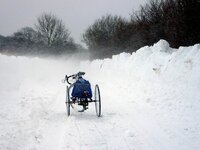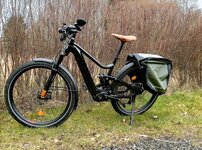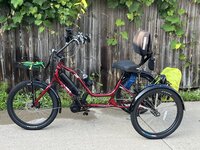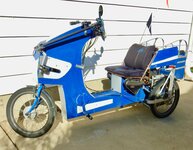Rudy Pekau
Member
- Region
- Canada
No need to postpone biking in the winter, some hardy people do it with studded tires on bikes on snowy and icy pathways,
some even go without studded tires and fat bikes which is okay when the pathways are dry, otherwise dangerous and scary, especially
on downhill sections on ice.
I have seen a bike with a kid trailer on a downhill section crashing on ice, rider and kid lucky to have no major injuries.
Some people like the challenge to stay upright on bikes on snow, it is a bit like skiing. The difference is when you crash on a bike
it is not as pleasant as wiping out with skis !
But there is an alternative to safe winter biking : an e-trike of the delta type, one wheel in the front, two wheels in the back;
If the most of the weight is on the rear axle, you are pretty safe and don't have to worry about crashing, even a little sliding in the curves
does not do any harm. But there are a few things to consider :
First, you have to dress warm as you are exposed to cold wind and you might not go for two hours but only for one hour unless you can warm up in between.
Second, you might warm up your bike in your garage or at home if you have that possibility. The battery at least should not be much below the freezing
temperature as the capacity and your range drops quite a bit in cold weather.The best thing is to take the battery indoors and keep it at room temperature.
I have been riding down to minus 10 deg. C, but usually I do not go when it is below minus 5 deg.C. it is more fun and you can ride longer.
Third, the amount of power you can transfer from you motorized wheel to the snowy or icy pathway depends on a number of factors:
Where the centre of gravity is, e.g. when you have front wheel drive trike and you go up a hill on snowy or icy pathways you will get very little traction
or propulsion, the wheel will spin out very fast and you do not make it up the hill, even with fat tires. Studded tires might help a bit here but not much !
Rear wheel drive is much better in this case as you have two wheels to drive if there is a differential or two motorized wheels on the rear axle !
I have been riding with rear wheel drive on my e-trikes several winters now and have only regular knobby bike tires, not fat tires, no problems on the hills.
Fourth, steering and negotiating curves, go slow, if you have front wheel drive applying power in a curve will make it worse, you will slide and not make
the curve, depending on where your center of gravity is, e.g. if you have semi recumbent trike where you sit further back with less weight on the front wheel
you will slide more, also it will spin out more on snowy hills.
Fifth,braking, I recommend braking mostly with the rear wheels as it straightens the trike especially on downhill sections. Do NOT brake much with the front
wheel when going downhill on snowy or icy pathways, it will turn you sideways pretty soon and you are in trouble ! Also, braking in a curve on snow with the front wheel
is a no-no, you will slide and go straight instead .
But I do not want to discourage you to go winter biking with an e-trike, it is lots of fun and after some time you will be able to push the limits and see what you can
do on snow and ice with an e-trike.
Anybody with winter riding experience using a tadpole type e-trike ( two wheels in the front , one wheel in the rear ) ?
some even go without studded tires and fat bikes which is okay when the pathways are dry, otherwise dangerous and scary, especially
on downhill sections on ice.
I have seen a bike with a kid trailer on a downhill section crashing on ice, rider and kid lucky to have no major injuries.
Some people like the challenge to stay upright on bikes on snow, it is a bit like skiing. The difference is when you crash on a bike
it is not as pleasant as wiping out with skis !
But there is an alternative to safe winter biking : an e-trike of the delta type, one wheel in the front, two wheels in the back;
If the most of the weight is on the rear axle, you are pretty safe and don't have to worry about crashing, even a little sliding in the curves
does not do any harm. But there are a few things to consider :
First, you have to dress warm as you are exposed to cold wind and you might not go for two hours but only for one hour unless you can warm up in between.
Second, you might warm up your bike in your garage or at home if you have that possibility. The battery at least should not be much below the freezing
temperature as the capacity and your range drops quite a bit in cold weather.The best thing is to take the battery indoors and keep it at room temperature.
I have been riding down to minus 10 deg. C, but usually I do not go when it is below minus 5 deg.C. it is more fun and you can ride longer.
Third, the amount of power you can transfer from you motorized wheel to the snowy or icy pathway depends on a number of factors:
Where the centre of gravity is, e.g. when you have front wheel drive trike and you go up a hill on snowy or icy pathways you will get very little traction
or propulsion, the wheel will spin out very fast and you do not make it up the hill, even with fat tires. Studded tires might help a bit here but not much !
Rear wheel drive is much better in this case as you have two wheels to drive if there is a differential or two motorized wheels on the rear axle !
I have been riding with rear wheel drive on my e-trikes several winters now and have only regular knobby bike tires, not fat tires, no problems on the hills.
Fourth, steering and negotiating curves, go slow, if you have front wheel drive applying power in a curve will make it worse, you will slide and not make
the curve, depending on where your center of gravity is, e.g. if you have semi recumbent trike where you sit further back with less weight on the front wheel
you will slide more, also it will spin out more on snowy hills.
Fifth,braking, I recommend braking mostly with the rear wheels as it straightens the trike especially on downhill sections. Do NOT brake much with the front
wheel when going downhill on snowy or icy pathways, it will turn you sideways pretty soon and you are in trouble ! Also, braking in a curve on snow with the front wheel
is a no-no, you will slide and go straight instead .
But I do not want to discourage you to go winter biking with an e-trike, it is lots of fun and after some time you will be able to push the limits and see what you can
do on snow and ice with an e-trike.
Anybody with winter riding experience using a tadpole type e-trike ( two wheels in the front , one wheel in the rear ) ?






